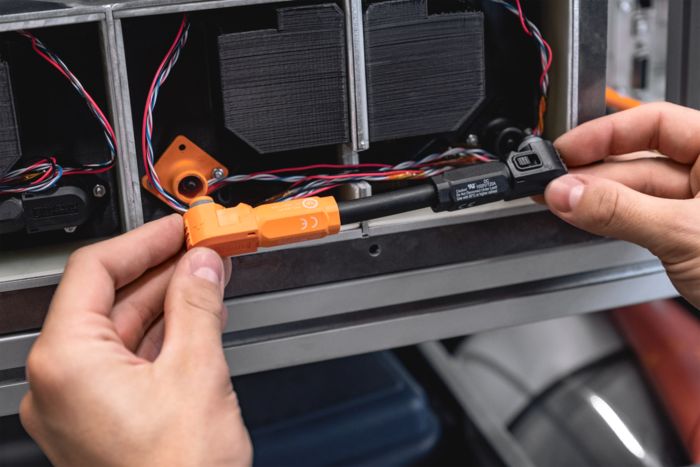With a passion for technology and motorsport The OWL Racing Team relies on robust connectors from Phoenix Contact.

Brief summary
In the heart of East Westphalia, a region of Germany known for its technological innovation, a team of students from the TH OWL University of Applied Sciences is working on the development of their new electric racing car to participate in Formula Student. Robust connectors from Phoenix Contact are being used in the battery for the first time.

Till Söffgen works at Phoenix Contact and is part of the racing team of the University of Applied Sciences in Lemgo
Reliability counts on the racetrack
The workshop at the TH OWL University of Applied Sciences in Lemgo, Germany, has a remarkable combination of technical expertise and passion for racing: The 35 students of the OWL Racing Team are working on their new design – the OWL 2.4 electric racing car, with which the team wants to participate in this year’s Formula Student.
In this global construction design competition, the students independently develop and build an electric racing car in accordance with a specified set of rules. For Till Söffgen, who heads the Powertrain subteam this year, not only does the result count, but also the continuous improvement of their car. “We are a fairly small team and, together with a few students, we not only have to design and build the racing car, but also keep it running and maintain it. It is therefore crucial for us to use robust and reliable components in our developments.”

Just push them on and they’re secure: The battery connectors are also ideal for use on the racetrack
New connection technology for the battery
The battery of the electric racing car, which has a capacity of 6.4 kWh and weighs around 70 kg, is one of the most complex components in the development. It consists of six battery segments, which together deliver a total voltage of 600 V. One of the notable changes compared to the previous year’s model concerns the connector system in the battery.
For the first time, the design team has included battery-pole connectors from Phoenix Contact in the design. Till Söffgen explains the decision: “We have a power limit of 80 kW, so around 133 A. We need a powerful connector that must also remain pluggable for a number of cycles.” The connectors are supplied preassembled and are easy to install. The connectors can still be operated easily even when we are wearing high-voltage gloves, which we need to do when working on the battery. “All-in-all, it’s the ideal system for us,” Söffgen sums up.
In addition to easy production and operation, the focus for the racing team from OWL is on the safety aspect in particular. “The regulations set out certain specifications in terms of safety, which we can easily meet with the battery-pole connectors from Phoenix Contact,” Söffgen makes clear. Touch-protected battery poles and mechanical coding ensure the required level of safety when connecting battery poles. The audible feedback when connecting ensures that a secure and durable connection has been made. “The connectors are subject to enormous vibrations on the track. It is therefore important that the connection is secure even under demanding conditions.”

The PCB connectors offer advantages especially in terms of user-friendliness
Safe monitoring
In addition to the battery connectors, the battery also uses data connectors from Phoenix Contact, which ensure the safe monitoring of the battery segments. The worst-case scenario for electric vehicles is well known: The battery overheats and causes the entire car to set on fire. To prevent this, the OWL Racing Team relies on continuous monitoring of the voltage and temperature of the battery cells.
One battery segment consists of 432 lithium round cells. PCBs with measuring electronics monitor these cells. The values are captured in the same way and transmitted internally via a board-to-board connector to the PCB with the monitoring IC. “For the board-to-board connectors, we chose the SMD version of the FQ 2,54 from Phoenix Contact. It was important to us that the connector is reliable and robust, as it also replaces a separate bracket frame for the upper PCB,” says Söffgen.
The voltage monitoring IC measures the values and transmits them to the main PCB via the CAN bus. “We draw the CAN bus and one supply voltage through the entire battery once.” The team uses PTSM PCB connectors for this. “The PTSM connectors have three main advantages for us: They are compact, SMT-compatible, and we do not have to crimp them,” explains Söffgen. The battery-internal CAN bus runs on a PTSM connection on the main PCB, where the data is evaluated. The controller checks whether a voltage or temperature measurement is too high and then, where necessary actuates contactors in the battery to prevent current flow, and the car is disconnected from the power supply.

The control device of the vehicle is integrated into the overall communication system via CAN bus
The heart of the battery
All the threads converge on the main PCB of the battery management system. This forms the interface between the battery and other control devices in the vehicle.
“Developing the main PCB is one of the biggest challenges,” explains Söffgen. However, the team can only meet the very specific specifications of the rules and regulations through in-house development, and has the necessary flexibility to respond quickly, e.g., in the event of an error.
Two circular connectors from Phoenix Contact form the data interface to the vehicle on the main PCB of the battery. The CAN bus and a 24 V supply voltage are routed via the circular connectors. The CAN bus system enables a significant reduction in cables and connectors, which in turn brings down the weight and significantly reduces the complexity of the cable harness. For example, the main control device for the drive control and the dashboard for the drivers receive all data via CAN bus. “By using preassembled CAN cables, we not only save a lot of time, but also have a tidy and reliable solution,” confirms Söffgen.
Measures for EMC protection
The circular connectors are part of a package of measures that the team has initiated this season to reduce electromagnetic interference. “With the KEB F6 inverter, powerful power electronics with around 80 kW are installed in the vehicle, which of course causes a lot of interference,” explains Söffgen. This led to frequent problems with the CAN bus last year.
This problem is now to be solved through various measures. These include electrical isolation of the CAN network on the PCB as well as its own power supply via the circular connector. “With the connector system in combination with the corresponding shielded cables, we have a very tidy, all-round shield and can equip the car against interference in the best possible way,” says Söffgen.
Summary
The racing team from East Westphalia is looking forward to the upcoming racing season with optimism: The reliability of the battery has been significantly improved with connectors from Phoenix Contact. After all, Formula Student is not just about podium finishes, but also about the safe design of the vehicle.
“If we pass the technical inspection, compete in the race, and then make it to the finish line, we’ll have achieved a lot,” says Söffgen. “But working together on the vehicle and the freedom to try out our own ideas is more important to us than the race itself – that is pretty cool.”
Connect with our experts

More posts

We’re on our way
And while the family is relaxing on the German island of Norderney or Juist, their electric vehicle is chilling at the charging station.

Sector coupling needs consistent communication
An interview with Martin Müller of Phoenix Contact on the lack of standards and looking beyond the horizon of the fieldbus world.

DC grids for sector coupling
E-mobility, solar systems, and battery storage systems are revolutionizing industry.



